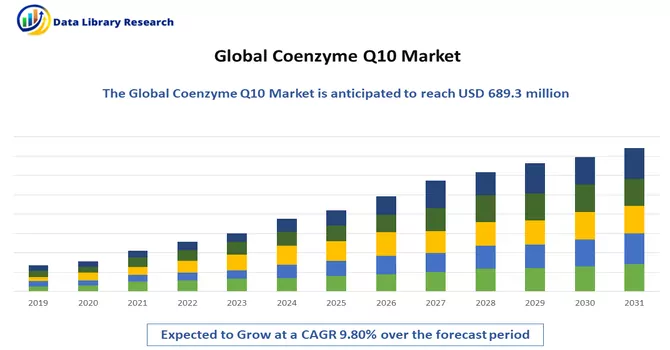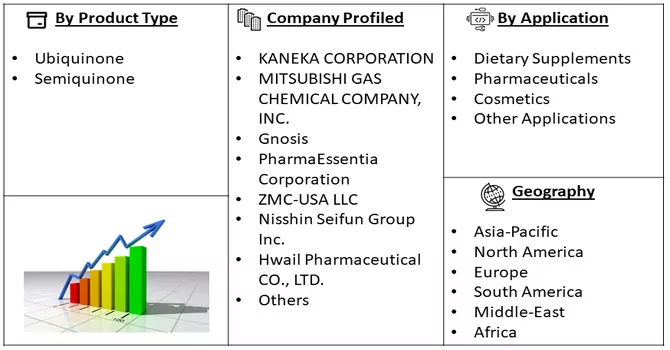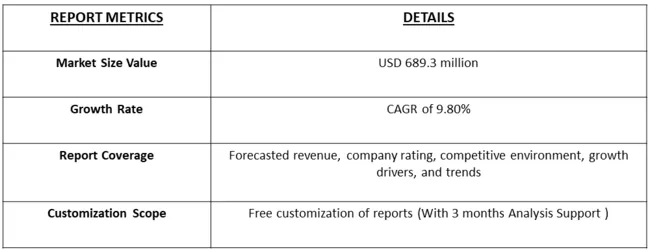The global coenzyme Q10 market size reached USD 689.3 million in 2023 and is expected to hit around USD 1,700.46 million by 2033, poised to grow at a CAGR of 9.80% from 2024 to 2033. The coenzyme Q10 market is driven by increasing rates of chronic illnesses, especially heart-related disorders.

Get Complete Analysis Of The Report - Download Free Sample PDF
The Global Coenzyme market is experiencing robust growth, fueled by increasing awareness of the essential role coenzymes play in various physiological processes. Coenzymes, vital for enzyme function and metabolic reactions in the human body, find extensive applications in the pharmaceutical, food and beverage, and cosmetic industries. The rising demand for dietary supplements and fortified food products, coupled with an ageing population seeking health and wellness solutions, is driving market expansion.
Moreover, advancements in biotechnology and the development of innovative coenzyme formulations are opening new avenues for growth. As consumers prioritize preventive healthcare, the global Coenzyme market is poised for continuous development, presenting opportunities for manufacturers to cater to the evolving needs of a health-conscious global population. A primary growth driving factor for the global Coenzyme market is the escalating demand for health and wellness products, emphasizing the essential role of coenzymes in supporting various physiological functions. As consumers increasingly adopt proactive approaches to healthcare, there is a rising interest in dietary supplements and fortified food and beverage products containing coenzymes. The ageing population's quest for solutions that promote vitality and longevity further propels the market, as coenzymes play a crucial role in cellular energy production and metabolic processes. The convergence of scientific advancements and consumer awareness regarding the significance of coenzymes is fostering innovation, and creating a favorable landscape for market expansion. This trend is expected to persist as the health-conscious consumer base continues to drive the global Coenzyme market towards sustained growth.
Market Segmentation: The Coenzyme Q10 Market is Segmented By Application (Dietary Supplements, Pharmaceuticals, Cosmetics, and Other Applications) and Geography (Asia-Pacific, North America, Europe, South America, and Middle East and Africa). The report offers market size and forecasts for pyrolysis oil in terms of revenue in USD million for all the above-mentioned segments.

For Detailed Market Segmentation - Download Free Sample PDF
The global Coenzyme market is characterized by several discernible trends shaping its trajectory. One prominent trend is the increasing incorporation of coenzymes in personalized nutrition and dietary supplements as consumers prioritize holistic well-being. The intersection of technological advancements and consumer preferences is driving innovation in coenzyme formulations, enhancing bioavailability and efficacy. Additionally, the rising popularity of functional foods and beverages enriched with coenzymes reflects a growing awareness of their health benefits. As the beauty and cosmetic industry explores the potential of coenzymes for skin health, there is a notable expansion into new application areas. Moreover, the emphasis on sustainable and plant-based sources of coenzymes aligns with the overall trend towards clean and natural ingredients. These trends collectively contribute to a dynamic and evolving landscape, positioning the global Coenzyme market at the forefront of nutritional and healthcare innovations.
Market Drivers:
The surge in consumer awareness about the importance of nutritional supplementation for overall health is fueling the demand for dietary supplements containing coenzymes
The global Coenzyme market is experiencing a notable surge driven by heightened consumer awareness regarding the pivotal role of nutritional supplementation in achieving overall health and well-being. As individuals increasingly prioritize preventive healthcare, there is a growing demand for dietary supplements enriched with coenzymes. Recognized for their essential contribution to metabolic processes and cellular functions, coenzymes have become sought-after components in wellness products. Consumers are proactively seeking solutions that address nutritional gaps and support their holistic health, spurring the expansion of the Coenzyme market. This trend underscores a paradigm shift in consumer behaviour towards a proactive approach to healthcare, positioning coenzyme-containing dietary supplements as integral elements in the pursuit of optimal health.
The cosmetics and personal care sector is driving market growth as coenzymes
The cosmetics and personal care sector is emerging as a significant driver for the global Coenzyme market, fueled by the increasing integration of coenzymes in beauty and skincare formulations. Coenzymes, renowned for their skin-enhancing properties and role in cellular metabolism, are becoming pivotal ingredients in anti-aging and skincare products. As consumers become more discerning about the efficacy and natural components of personal care items, the demand for coenzyme-infused cosmetics is on the rise. This trend is not only driven by the desire for aesthetic benefits but also reflects a growing understanding of coenzymes' potential in promoting skin health. The cosmetics industry's embrace of coenzymes highlights a convergence of science and beauty, shaping the market's growth trajectory and contributing to the development of innovative and wellness-focused beauty solutions.
Market Restraints:
Despite the promising growth, the global Coenzyme market faces certain market restraints that impact its trajectory. One significant challenge is the high production costs associated with isolating and synthesizing coenzymes, posing economic barriers for both manufacturers and consumers. The regulatory landscape surrounding nutritional supplements and health claims presents another restraint, creating complexities that may hinder market entry and product development. Additionally, variations in consumer awareness levels across regions and potential skepticism about the efficacy of coenzyme-enriched products may limit market penetration. Furthermore, the reliance on specific sources for coenzymes, such as fermentation or extraction from certain plants, poses supply chain vulnerabilities. Navigating these challenges requires strategic efforts from industry stakeholders, including addressing cost concerns, advocating for favourable regulations, and advancing research to enhance production efficiency and diversified sourcing.
The global Coenzyme market has experienced notable impacts due to the COVID-19 pandemic, with disruptions reverberating across the supply chain and demand dynamics. The lockdowns and restrictions implemented to curb the virus's spread led to manufacturing and distribution challenges, affecting the production of coenzyme-enriched products. Consumer spending patterns also shifted during the pandemic, with a focus on essential goods rather than discretionary items like supplements, impacting the demand for coenzyme-based dietary products. Additionally, delays in research and development activities may have slowed down the introduction of new coenzyme formulations. However, as the world moves towards recovery, the market is expected to rebound, driven by a renewed emphasis on health and wellness, potentially leading to increased consumer interest in coenzyme-containing supplements and beauty products. The long-term impact will likely involve adaptation to evolving consumer behaviours and a resilient focus on health-related product innovations within the global Coenzyme market.
Segmental Analysis:
Pharmaceutical Segment is Expected to Witness Significant Growth Over the Forecast Period
Coenzyme Q10 (CoQ10) and glucosamine sulfate are both popular dietary supplements known for their potential health benefits. Coenzyme Q10, also known as ubiquinone, plays a crucial role in the production of energy in cells and acts as an antioxidant, helping to protect cells from damage. It is often used as a supplement to support heart health, improve energy levels, and counteract the effects of certain medications that deplete CoQ10 levels in the body. Glucosamine sulfate is a naturally occurring compound found in the fluid around joints. It is commonly used as a supplement to support joint health and reduce inflammation, particularly in conditions such as osteoarthritis. Glucosamine sulfate is believed to help maintain the integrity of cartilage and may help reduce pain and improve joint function in people with arthritis. Together, CoQ10 and glucosamine sulfate are often included in joint health supplements to provide comprehensive support for joint function and overall health. While they work through different mechanisms in the body, both supplements are popular choices for individuals looking to support their joint health and overall well-being.
North America Region is Expected to Witness Significant Growth Over the Forecast Period
North America is a key market for glucosamine sulfate, driven by a large population seeking joint health solutions. The region's aging demographic and active lifestyle trends contribute to the demand for supplements and pharmaceuticals containing glucosamine sulfate. North America's well-established regulatory framework and consumer awareness of health and wellness further support the market growth. Additionally, the region's strong distribution network and retail presence enable easy access to glucosamine sulfate products. Overall, North America's market presents lucrative opportunities for companies in the glucosamine sulfate industry to expand their presence and meet the growing demand for joint health solutions.

Get Complete Analysis Of The Report - Download Free Sample PDF
The analyzed market exhibits a high degree of fragmentation, primarily attributable to the presence of numerous players operating on both a global and regional scale. The competitive landscape is characterized by a diverse array of companies, each contributing to the overall market dynamics. This fragmentation arises from the existence of specialized solution providers, established industry players, and emerging entrants, all vying for market share. The diversity in market participants is underscored by the adoption of various strategies aimed at expanding the company presence. On a global scale, companies within the studied market are strategically positioning themselves through aggressive expansion initiatives. This often involves entering new geographical regions, targeting untapped markets, and establishing a robust global footprint. The pursuit of global expansion is driven by the recognition of diverse market opportunities and the desire to capitalize on emerging trends and demands across different regions. Simultaneously, at the regional level, companies are tailoring their approaches to align with local market dynamics. Regional players are leveraging their understanding of specific market nuances, regulatory environments, and consumer preferences to gain a competitive edge. This regional focus allows companies to cater to the unique needs of local clientele, fostering stronger market penetration. To navigate the complexities of the fragmented market, companies are implementing a range of strategies. These strategies include investments in research and development to stay at the forefront of technological advancements, mergers and acquisitions to consolidate market share, strategic partnerships for synergies, and innovation to differentiate products and services. The adoption of such multifaceted strategies reflects the competitive nature of the market, with participants continually seeking avenues for growth and sustainability. In essence, the high fragmentation in the studied market not only signifies the diversity of players but also underscores the dynamism and competitiveness that drive ongoing strategic maneuvers. As companies explore various avenues for expansion, the market continues to evolve, presenting both challenges and opportunities for industry stakeholders.
Coenzyme Q10 Market Companies.
Recent Developments:
1) Fortifeye Vitamins, a leader in eye health, is excited to introduce the Fortifeye Next Gen Zinc-Free Macular Defense Formula in July 2023. This revolutionary supplement caters to individuals with zinc sensitivities and marks a significant advancement in combating age-related macular degeneration (AMD).
2) In April 2023, NIVEA Q10 stands out as Beiersdorf's flagship face care line, a product revered within the company every second. This esteemed line is available in over 60 countries, showcasing its widespread popularity. The success of the Q10 series can be attributed to coenzyme Q10, which pioneered its way as the first active ingredient in mass-market cosmetics 25 years ago. This year marks a significant milestone for Beiersdorf, as it introduced the first skin care products featuring this active ingredient under the NIVEA brand. Even today, Q10 remains one of the most crucial active components in anti-ageing products, continually yielding groundbreaking discoveries that benefit the global scientific community.
Q1. How big is the Coenzyme Q10 Market ?
The coenzyme Q10 market size reached USD 689.3 million in 2023 and is expected to hit around USD 1,700.46 million by 2033.
Q2. At what CAGR is the Coenzyme Q10 Market projected to grow within the forecast period?
Coenzyme Q10 Market is poised to grow at a CAGR of 9.80% over the forecast period.
Q3. Which region has the largest share of the Coenzyme Q10 market? What are the largest region's market size and growth rate?
North America has the largest share of the market. For detailed insights on the largest region's market size and growth rate request a sample here.
Q4. Who are the key players in Coenzyme Q10 market?
Some key players operating in the market include
Data Library Research are conducted by industry experts who offer insight on industry structure, market segmentations technology assessment and competitive landscape (CL), and penetration, as well as on emerging trends. Their analysis is based on primary interviews (~ 80%) and secondary research (~ 20%) as well as years of professional expertise in their respective industries. Adding to this, by analysing historical trends and current market positions, our analysts predict where the market will be headed for the next five years. Furthermore, the varying trends of segment & categories geographically presented are also studied and the estimated based on the primary & secondary research.
In this particular report from the supply side Data Library Research has conducted primary surveys (interviews) with the key level executives (VP, CEO’s, Marketing Director, Business Development Manager and SOFT) of the companies that active & prominent as well as the midsized organization
FIGURE 1: DLR RESEARH PROCESS

Extensive primary research was conducted to gain a deeper insight of the market and industry performance. The analysis is based on both primary and secondary research as well as years of professional expertise in the respective industries.
In addition to analysing current and historical trends, our analysts predict where the market is headed over the next five years.
It varies by segment for these categories geographically presented in the list of market tables. Speaking about this particular report we have conducted primary surveys (interviews) with the key level executives (VP, CEO’s, Marketing Director, Business Development Manager and many more) of the major players active in the market.
Secondary ResearchSecondary research was mainly used to collect and identify information useful for the extensive, technical, market-oriented, and Friend’s study of the Global Extra Neutral Alcohol. It was also used to obtain key information about major players, market classification and segmentation according to the industry trends, geographical markets, and developments related to the market and technology perspectives. For this study, analysts have gathered information from various credible sources, such as annual reports, sec filings, journals, white papers, SOFT presentations, and company web sites.
Market Size EstimationBoth, top-down and bottom-up approaches were used to estimate and validate the size of the Global market and to estimate the size of various other dependent submarkets in the overall Extra Neutral Alcohol. The key players in the market were identified through secondary research and their market contributions in the respective geographies were determined through primary and secondary research.
Forecast Model
